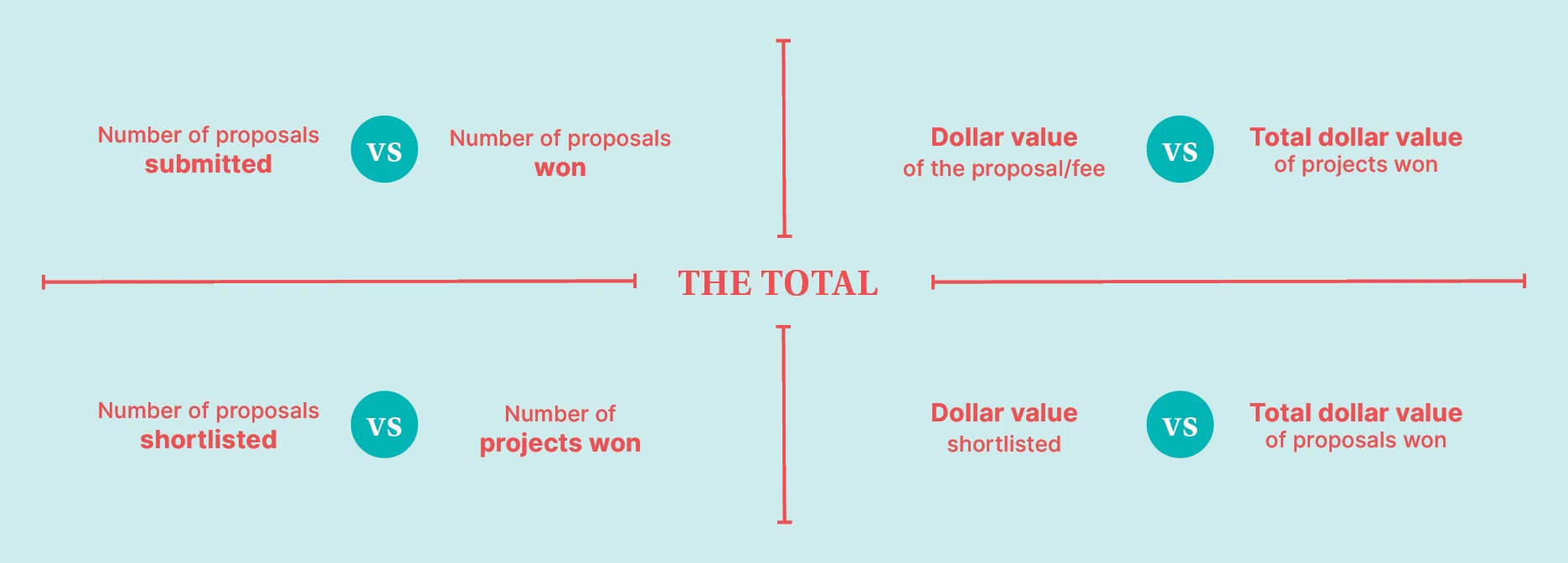newsletter
Sign up for the Marketer QuickLook Newsletter
SMPS Headquarters
625 North Washington Street
Suite 302
Alexandria, VA
22314-1936
email
info@smps.org
phone
703.549.6117



Refresh
Measuring:

By Kathryn Ness, CPSM, Chuck Raymond, CPSM, and Joy Woo, FSMPS, CPSM, LEED AP
feature
for Success

Return on investment and key performance indicators (KPIs) today, and what has changed since the SMPS Foundation’s publication was issued in 2016.
As the A/E/C industries expand and contract and the economy make its twists and turns, we adjust our business strategies and practices to adapt. Yet, how do we know we have adapted effectively and efficiently? Business development and marketing are major investments for our companies and crucial to their ability to win work. Measuring our hit rates and how our investments are performing through KPIs are more important than ever. Setting the stage through strategic planning and developing initiatives to reach our goals includes tracking the performance of those initiatives. Yet, we all know that.
As an incoming Foundation trustee, I went back and looked at the Foundation’s previously published research. Being very attuned to strategic planning and measuring performance, the 2016 publication, “Measuring for Success: A Look at Hit Rates & Other KPIs in the A/E/C Industries,” really stood out to me, and my innate sense of curiosity made me dive in!
Today, seven years after its 2016 publication, I anticipated it would be outdated and perhaps not as applicable. However, these measurements and tracking metric for marketing and business development’s return on investment are more applicable now, than ever. It’s about efficiency and effectiveness. As our industries continue pursuing efficiencies, marketing and business development activities must demonstrate value as important investments in a firm’s strategic growth (not “just overhead” that can be cut.)
In the A/E/C industries, hit rates (those using the number of proposals) and capture rates (those based on the dollar value) are measured in different ways:

Simple, scalable formulas can help track your progress. The publication provides breakdowns on their effectiveness and impacts based on competitive proposals. I highly recommend downloading this publication and sharing it with your team - including leadership - so you can begin managing what you can measure or refine your approach if you are already using this KPI.
Other methods of measuring marketing and business development effectiveness include assessing results based on:
• Noncompetitive submittals
• Subconsultant work partnerships
• Work from an MSA/”on call” agreement
Tracking may also vary among disciplines, such as engineering, architecture, and construction firms. Start from what will work best for your firm. If your firm is typically a subconsultant, consider tracking the primes and what your hit rate is with each of them.
Marketing and business development mean more than proposals and hit rates, so I dug in a little deeper.

AI’s Findings on Measuring ROI, Hit Rates, and KPIs
I was curious what AI would bring up for hit rates and KPIs. While this article is not written by AI, the findings that it produced on A/E/C industry-wide ROIs, KPIs, and hit rates were. The results, while not based on primary and secondary research, included many of the business development activities in which we engage to win work.
The first stages of business development are part of the winning work process and are an investment in just that — winning work. Some of the areas where we invest before the proposal even hits the street, include:

Kathryn Ness, CPSM, is a partner at GO Strategies in Roseville, CA.
Connect with Kathryn on
Chuck Raymond, CPSM, is Director of Communications for Weston & Sampson in Worcester, MA
Connect with Chuck on
Firms track these costs using KPIs such as:
Client Acquisition Cost (CAC)
Calculated by dividing the total costs of acquiring clients by the number of clients acquired. CAC helps in understanding the efficiency of client acquisition strategies.
Conversion Rates
Track the percentage of leads that convert into actual projects or contracts. This provides insights into the effectiveness of marketing and business development efforts.
Client Retention Rates
Assess the ability of the firm to retain clients over time, which is crucial for long-term profitability.
Revenue Growth
Measure the overall growth in revenue attributed to business development and marketing efforts.
Return on Marketing Investment (ROMI)
Compare the revenue generated from marketing activities to the cost of those activities to determine the overall return on investment.
Keeping It Simple
All these KPIs could be overwhelming and confusing. Where do you start? If your firm is not currently tracking your hit rate or your business development initiatives, don’t get overwhelmed! Start by keeping track of the number of proposals you’ve submitted, and the number won, working with your CFO and accounting department to get the numbers. You can set up a tracking system for hit rate even without a sophisticated CRM system. For capture rate, you simply need the value of the expected revenue of those proposals.
In the PSM.show Amazing Hit Rates are Possible, Just Ask Chelsea Pozar and Gabe Lett (#235), Gabe Lett, FSMPS, CPSM, shared that he started tracking hit rate through an “informal” go/no-go process that he set up for himself. He tracked his firm’s proposals and the process to gauge their effectiveness and saw their win rate jump from 37% in 2019 when he began at his firm and a 41% hit rate, to a 51% hit rate and 52%-win rate in 2020. Refining this process allowed Gabe to learn how to predict their win or loss almost 80% of the time. In 2022, with consistent use of their go/no-go process, their hit rate is now 68% with a 75%-win rate. That is effective and impactful tracking and amazing win rate!
Starting with tracking information that you can gather, follow it for some time, measure the results, and then share with your leaders and your team on how tracking this information can influence and change behaviors in how and what work to pursue.
Gabe’s Two Traditional Tracking Formulas Used:
Hit Rate
# of competitive proposals won divided by # of competitive proposals pursued
Win Rate
$ revenue won divided by
$ revenue pursued
Joy Woo, FSMPS, CPSM, LEED AP, is the Senior Director at the Urban Land Institute, San Francisco District, in San Francisco, CA.
Connect with Joy on
Conclusion
The tracking and methodologies used to determine ROI and KPIs have not changed much since publication of the 2016 Foundation report. Due to the increase in design/build projects, a slight adjustment has been identified for these projects. Regularly tracking and analyzing these metrics will provide valuable insights into the effectiveness of business development and marketing efforts for your firm across the A/E/C industries. Create a tracking process and system that is effective for your firm and measure what you need to help optimize your ROI and adjust your strategies based on those findings. Measuring and tracking will provide data to help inform strategic initiatives, support key pursuits decision, and help your firm make better go/no-go decisions. I encourage you to download the 2016 report and see how you can start tracking your hit and win rates, return on investments, and how well your firm has met the key performance indicators.
Share:
READ NEXT

























